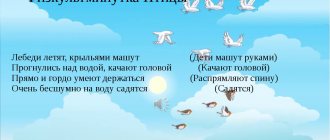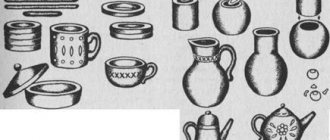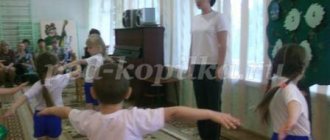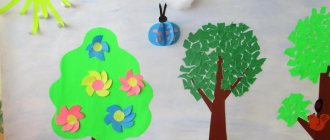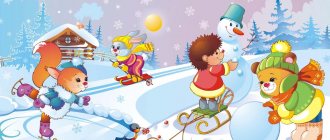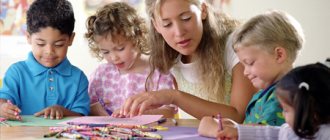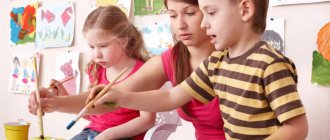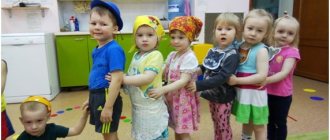Conducting an educational activity on drawing on a chosen topic with children 6–7 years old
The object of the study is the process of drawing expressive images by children of senior preschool age using non-traditional techniques.
Subject of research: pedagogical possibilities of non-traditional techniques and materials in the development of expressive images in the drawings of children of senior preschool age.
Tasks:
- Study psychological and pedagogical literature and literature on the visual activities of children in a preschool institution;
- Make an analysis of the age characteristics of older preschoolers and the quality of children's drawings;
- Conduct research work on the quality of children's drawings using non-traditional techniques;
- Develop a development program for the development of creative abilities in art classes using non-traditional drawing techniques.
Carrying out educational activities with children 6-7 years old
A selection of demonstration materials for the conversation (photos and drawings)
Demonstration material is selected in accordance with the topic. The kindergarten teacher prepares illustrations from which new drawings, layouts, reproductions, subject or didactic pictures will be created. A perspective free plan helps children create expressive images.
Music and poetry appropriate to the topic of the lesson
To instill interest in artistic activity, the teacher must satisfy the needs of preschoolers. It is very important to select music according to the topic. For example, if a masterpiece is created on the theme “Winter”, then you need to choose the tunes “If only there were no winter”, “Three White Horses”, “New Year”, “Snow Maiden”. During the warm-up, you can read poetry, for example, “The bird that sings in the garden.”
Summary of a drawing lesson in the chosen technique in the preparatory group
Drawing in the preparatory group according to the Federal State Educational Standard is a unique way of understanding the world and developing knowledge of aesthetic education, since it is associated with the child’s independent practical and creative activity.
Systematic mastery of all necessary means and methods of activity provides children with the joy of creativity and their all-round development (aesthetic, intellectual, moral-labor, physical). It also allows us to fruitfully solve the problems of preparing children for school.
Examples of finished works
Children put their finished work on the table so that the teacher can evaluate their talent. Most often, children like to draw images on the theme “Defender of the Fatherland Day”, “March 8”, “Autumn”, “Spring has come”, “The coldest month”, “Profession”, “Forest”, “Why day follows night”, “Clothing” ", "Our kindergarten is like a home."
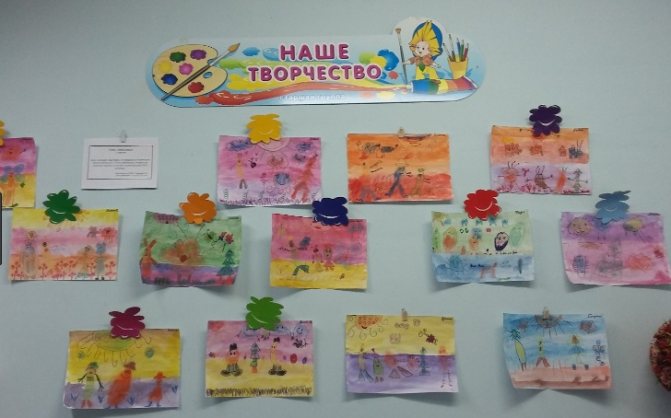
Works of preschoolers
The most popular theme for children is “Headdress”. The children learn to correctly name hats and their parts, telling what types they come in. For example, to come to the beach, you need to wear a Panama hat and a hat. When late autumn comes, women wear scarves and light scarves. And already in February and January you need to wear a warm pompom.
Moral education of preschool children
Preparing for a drawing lesson in the preparatory group
Preparation for a drawing lesson in the preparatory group is carried out with the development of artistic creativity. During the class, unconventional drawing techniques are improved using watercolors and wax crayons. Children should be able to distinguish between warm colors and shades.
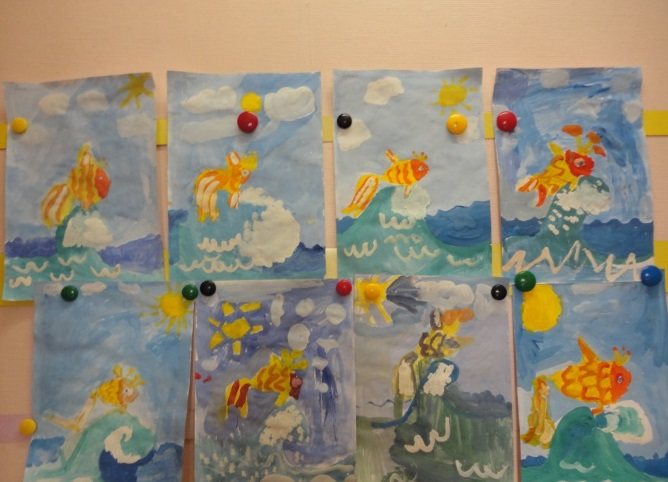
How to prepare a preschooler for a drawing lesson
Types of drawing for preschoolers 6–7 years old
At the age of 6-7 years, children have a well-developed imagination. The teacher introduces them to the basic tools needed to create a drawing. Many talented children have a desire to improve their skills. They start drawing beautiful pictures. In the preparatory group, drawing on the theme “March” is carried out using an unconventional technique.
Important! When choosing a technique for creating drawings for children 6-7 years old, it is necessary to take into account that the use of paints, crayons, and pencils requires possession of certain skills, so in the first stages of creativity it is better to choose what will be easier for the child.
The teacher selects art material in advance. A preschooler can draw objects, favorite characters, decorative patterns, and pets. Teachers use colored pencils, watercolors, and gouache paints. Using a pencil you can create a linear shape. The child begins to draw one part after another, gradually adding various elements. After this, the outline should be colored with colored pencils.
Gouache and watercolor create shapes from a spot of paint, rather than from an outline. With the help of paints, a child can convey the richness of the environment, for example, the sea, the sun, the stars, etc. To create a masterpiece using a pencil, you need to be well versed in unconventional drawing techniques.
The preparatory group uses additional materials to create the drawing. Among them are the following:
- pastel;
- sanguine;
- colored crayons;
- charcoal pencil.
Using charcoal and sanguine, you can get a one-color design. Therefore, you need to focus on the form and conveying the texture of a certain object. Colored crayons greatly facilitate the process of painting large surfaces and large shapes. Pastels are designed to convey a variety of shades.
Modeling is a kind of children's fun that adds fun to the process of completing a task. Children love animals, cartoon characters, transport, toys. Modeling will allow you to master technical techniques. That is, the child first sculpts the object in a static position, and then bends its parts in accordance with the plan.
The appliqué activity introduces the preschooler to simple and complex shapes of various objects. The guys begin to create silhouettes that they cut out and paste. This method promotes the development of mathematical concepts.
An open drawing lesson is often conducted using a cotton swab and gouache. In the process of doing work, children learn to mix paints and get different shades.
Didactic games for older children
Handouts needed for the lesson
To develop the ability to create drawings, it is necessary to prepare handouts, which consist of the following:
- template,
- gouaches,
- thin brush,
- jars of water,
- napkins.
Individual approach and team work with children
During the lesson, an individual approach is provided. The need for physical activity is realized through physical education sessions.
The teacher tells the children that guests have come to them, so they need to say hello. This technique is aimed at developing communication skills. Children should know how to behave with adults and peers. In addition, the teacher cultivates independence and accuracy. Every child who attends kindergarten should know how to monitor their posture.
Note! Before doing the work, the teacher introduces each child to the illustrations, looks at books with them, and also tells new material.
Step-by-step instructions for drawing the selected plot
Summary of a drawing lesson on the topic “Butterfly”. Children continue to get acquainted with non-traditional drawing techniques. Children must learn how to create a drawing using the monotype technique, and also independently choose the color scheme of paints that matches the joyful summer mood.
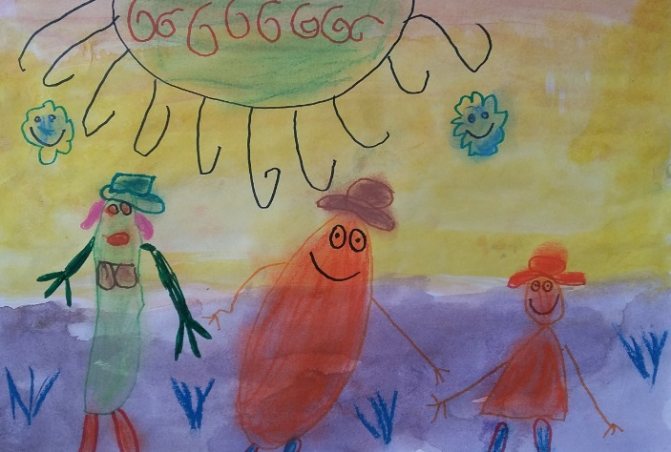
Selected scene
Note! Develops color perception and improves fine motor skills of fingers and hands.
Materials and equipment:
- images with butterflies,
- paper folded in half,
- gouache,
- tassel,
- container with water,
- palette,
- cloth
Drawing technique in the preparatory group according to the Federal State Educational Standard
The main principle of teaching children of any age to draw is clarity: the child must know, see, feel the object or phenomenon that he is going to depict. Children should have clear, precise ideas about objects and phenomena. There are many visual aids used in drawing classes. All of them are accompanied by verbal explanations.
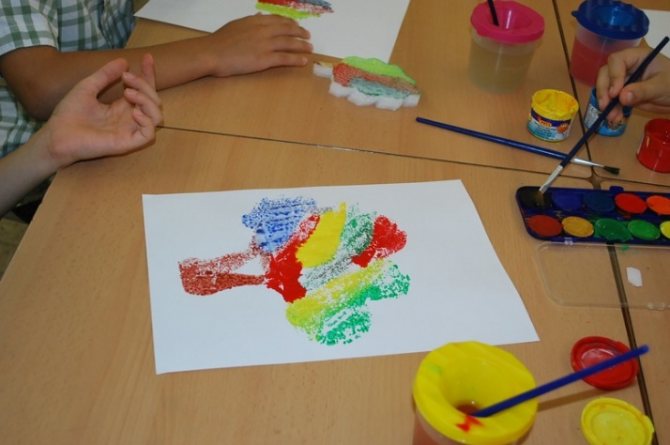
Method of art
When thinking through exercises, as well as a system of tasks aimed at developing visual skills, you should remember that literal repetition of the same tasks is boring for children. This process does not lead to success. For example, when drawing on the topics “Where the birds will winter,” “Fairy-tale trees,” “Trees on our site,” “Autumn square,” “Winter forest,” a preschooler depicts trees, conveying parts, structure, and solves composition problems.
Options for individual and collective drawings in different techniques (including non-traditional)
The use of paintings in classes in the preparatory group not only helps the teacher in clarifying children’s ideas about a particular subject, but also introduces them to some visual techniques. For example, a girl is playing with a ball - her hands are drawn up.
Sometimes a picture can be used in the drawing process when a child has forgotten the shape of some part or the details of an object; after examining it, the teacher removes it to prevent children from copying it. The picture, like the teacher’s drawing that replaces it, cannot serve as a model for a child’s drawing and cannot be used for copying.
Important! The perception of the picture should be based on observations in life, helping the child to realize what he saw.
